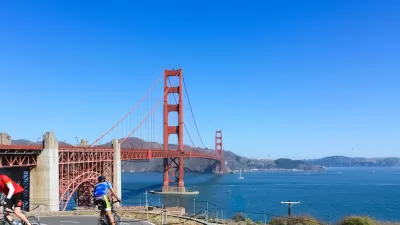The Golden Gate Bridge District is looking at ways to improve safety on the bridge's narrow, windy bike and pedestrian paths.

According to data from the Marin County Bicycle Coalition and a Golden Gate Bridge District study, "a cyclist is five times more likely to crash traversing the Golden Gate Bridge as a motorist, and 21 times more likely to be injured." This indicates the need for improved bike and pedestrian infrastructure on the famous bridge, writes Roger Rudick.
The data shows that "there were 19 times as many solo bicycle collisions as there were bicycle-pedestrian collisions," partly due to newly installed fence slats that "amplify gusts, knocking cyclists over." The Coalition "is urging cyclists to participate in an outreach program, recently launched by the Bridge District, to get feedback and more information to figure out how to reduce crashes."
"[T]he District’s study, released last year, includes some specific improvements, such as: 'install additional high visibility wind warning signage along the west sidewalk to raise awareness' and 'implement a Standard Operating Procedure to shift bicycle traffic to the east sidewalk during hazardous wind conditions.'" The MCBC's assessment "also puts partial blame on Bridge District maintenance crews that use the path as a storage area," leaving less room for bicyclists to maneuver. "We are surprised to see that the study does not make any recommendations to increase clearances for two-way bike traffic going past construction material." Streetsblog comments that "crews would never regularly store materials in a motor-vehicle lane on the bridge, certainly not without significant traffic diversions and guidance. So why is a bike path seen as a suitable place to dump stuff?"
"MCBC is asking riders of the Golden Gate Bridge to check out all their recommendations, review the District’s study, participate in the outreach program, and take the Golden Gate Bridge District poll."
FULL STORY: New Push For a Safer Golden Gate Bridge

Maui's Vacation Rental Debate Turns Ugly
Verbal attacks, misinformation campaigns and fistfights plague a high-stakes debate to convert thousands of vacation rentals into long-term housing.

Planetizen Federal Action Tracker
A weekly monitor of how Trump’s orders and actions are impacting planners and planning in America.

In Urban Planning, AI Prompting Could be the New Design Thinking
Creativity has long been key to great urban design. What if we see AI as our new creative partner?

Massachusetts Budget Helps Close MBTA Budget Gap
The budget signed by Gov. Maura Healey includes $470 million in MBTA funding for the next fiscal year.

Milwaukee Launches Vision Zero Plan
Seven years after the city signed its Complete Streets Policy, the city is doubling down on its efforts to eliminate traffic deaths.

Portland Raises Parking Fees to Pay for Street Maintenance
The city is struggling to bridge a massive budget gap at the Bureau of Transportation, which largely depleted its reserves during the Civd-19 pandemic.
Urban Design for Planners 1: Software Tools
This six-course series explores essential urban design concepts using open source software and equips planners with the tools they need to participate fully in the urban design process.
Planning for Universal Design
Learn the tools for implementing Universal Design in planning regulations.
Gallatin County Department of Planning & Community Development
Heyer Gruel & Associates PA
JM Goldson LLC
City of Camden Redevelopment Agency
City of Astoria
Transportation Research & Education Center (TREC) at Portland State University
Jefferson Parish Government
Camden Redevelopment Agency
City of Claremont



























